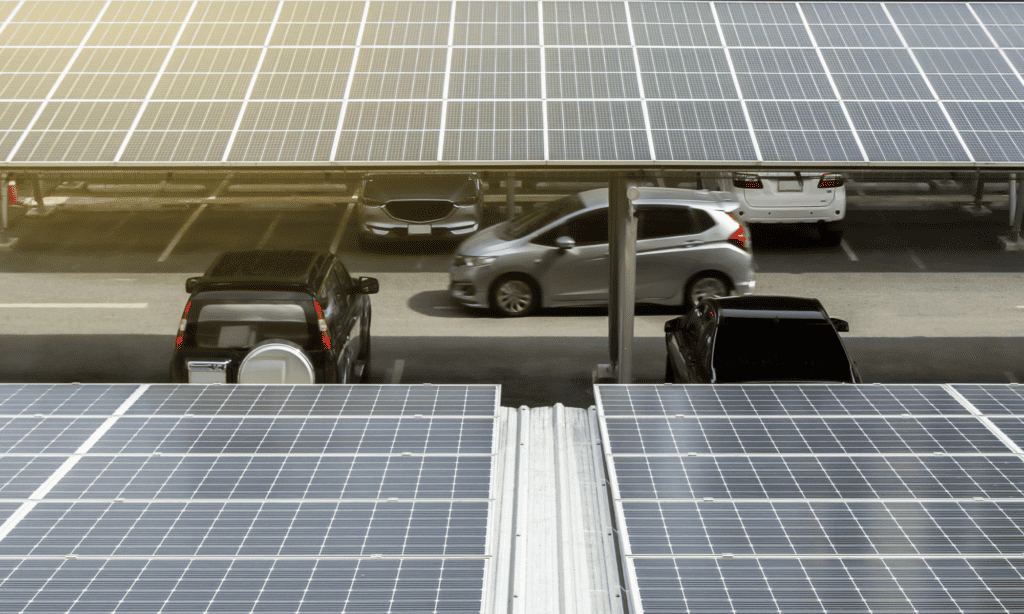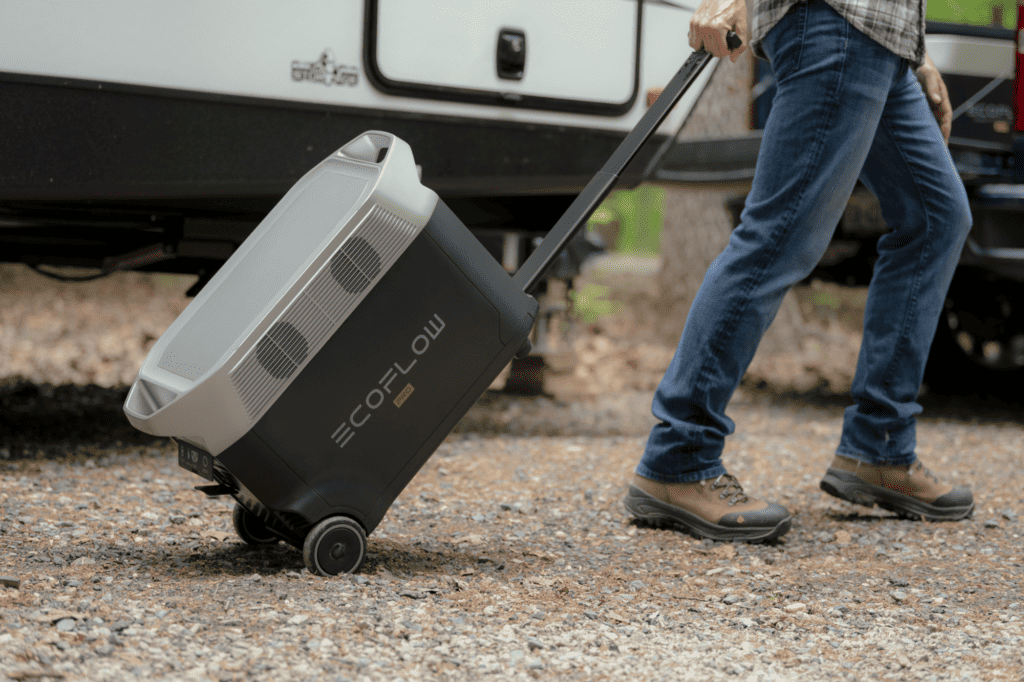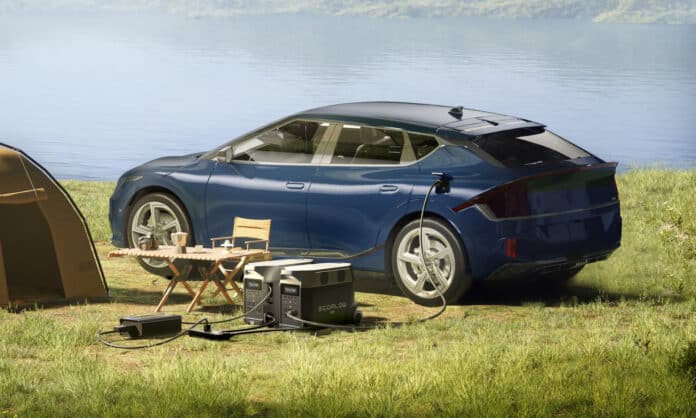Table of Contents
With electric vehicles (EVs) and hybrids becoming commonplace as we strive to live sustainably, many people are in search of portable EV charging solutions.
According to Automotive News, “there were 21,242 Level 2 public charging ports and 4,766 DC fast-charging ports operating across Canada at the end of 2023.
Finding a place to recharge is nowhere near as challenging as it used to be.
Even still, you may prefer to have the additional energy security of having a portable EV charger that you can take with you anywhere.
You never know when you might find yourself running out of juice with miles to go to the next EV charging station.
But is it really feasible to charge a massive EV battery with a portable device?
Read on to find out.
Can You Really Charge an EV With a Portable Charger?
Believe it or not, the answer is yes.
Much in the same way that you couldn’t refill your traditional car with a gas can, you can’t recharge your EV from 0-100% with a portable power station.
However, there are affordable and powerful solutions that buy you enough miles to get you off the side of the highway and back on the road to the nearest compatible EV charging station.
For example, EcoFlow’s DELTA Pro portable power station provides 3.6 kilowatts of AC output (7.2kW surge power) and 3.6kWh of storage capacity (expandable with EcoFlow Smart Extra Batteries).
You can purchase an EV Backup Charging Solution as a bundle that includes:
- 1 x EcoFlow DELTA Pro
- 1 x EV X-Stream Adapter
- 1 x Grounding Adapter
That’s everything you need to give your EV a boost and to recharge the PPS at any EV charging station while you “refuel” your vehicle.
Like all EcoFlow portable power stations, DELTA Pro also supports solar charging (1,600W solar input), so you can even charge your EV with solar panels.
Connect up to 4 x EcoFlow 400W portable solar panels to turn your DELTA Pro into a solar generator and recharge anywhere the sun shines — even at the side of the road.
What Size Portable EV Charger Do I Need?
The AC output and storage capacity specification of a portable EV charger that will meet your needs depends on numerous factors, including:
- Make and model of your electric vehicle
- Acceptable charge time
- Additional drive time required
The average electric car battery in 2024 weighs around 1,000 pounds.
It goes without saying that no “portable” EV charger can fully recharge a dead EV battery from zero.
The best way to determine what size portable EV charger you need is to calculate the average run time you would need to get to the nearest charging station if you “run out of gas.”
EV Charge Stations by Location
The US Dept. of Energy provides a valuable resource that pinpoints EV charge stations by location in the US and Canada. You can also filter by charger and connector type, and free smartphone apps are also available.
Using the EV charging station map, it’s easy to calculate the average distance between stations based on where you live or where you’ll be travelling.
Once you’ve decided on how much additional run time you’d like a portable EV charger to supply, it’s time to calculate how much power you need.
The charge times and input requirements of EVs vary significantly by manufacturer. You’ll need to consult your car’s manual or manufacturers to determine exactly what you need.
Courtesy of Car and Driver, above are the charge rates for a short list of popular EVs.
(Source: Lifewire)
EV Charging by Level (1, 2, 3)
First off, what charge level does your EV accept? 1, 2, 3 (or all three?)
Level 1 EV Charging
Level 1 is the dinosaur of EV charging solutions.
A more charitable way of looking at it is as a last resort.
Level 1 (L1) charging uses 120V single-phase electricity, and it can take days (40-50+ hours) to fully charge an EV.
On the bright side, every EV comes with an L1 charge cable, and you can plug it directly into a standard household wall socket.
With a maximum AC output of 2.4 kW, you can expect about 5 miles of additional drive time per hour of charging.
If you leave your EV plugged into an L1 charger for 8 hours a day when you’re at work, you can count on about 40 miles of driving.
L1 may be slow, but for many people, it’s fast enough to “fuel” their daily commute.
Most emergency and portable EV chargers supply L1 charging.
DELTA Pro can provide L1, but you’ll get better results with Level 2.

Level 2 EV Charging
Level 1 has its place for charging EVs. It’s easy to access and accepted by every manufacturer and model.
But for most applications, L2 charging takes EV driving to the next level.
Dedicated home EV chargers and solar carports typically use Level 2 technology to provide faster charge times and higher charge rates.
Residential (and portable) L2 EV charging requires:
- 240V single-phase AC output
- 2.5kW – 19.2kW charge load (avg. 7kW)
L2 electricity parameters are well out of reach for most portable emergency EVs or “trickle” chargers.
Not so for EcoFlow DELTA Pro.
Out of the box, EcoFlow DELTA Pro offers 3.2 kW of continuous AC output and 3.2 kWh of storage.
In simple terms, it can charge an EV for a full hour at a charge load of 3.2 kW.
According to the US Dept. of Transportation, battery electric vehicles (BEV) charge from 0-80% in 4-10 hours, and plug-in hybrid electric vehicles (PHEV) charge from 0-80% in 1-2 hours.
EcoFlow DELTA Pro can’t recharge any BEV from zero-100%, but it can be the difference between making it to the next charging station and being stranded at the side of the road.
Using the Tesla Model Y as an example, EcoFlow DELTA pro can extend your range by an additional 14 miles.
Is 14 miles going to be enough to get you to the nearest charging station?
It largely depends on where you’re stuck.
If you run out of power in the prairie provinces you may be in for a long wait or an even longer walk.
Level 3 EV Charging (DC Fast Charge)
Level 3 chargers — also known as DC Fast Charging and DCFC — are the gold standard for charging EVs that accept them.
Unfortunately, Superchargers are hard to come by except on major highways and high-traffic corridors.
DC Fast Charging typically requires a three-phase AC input, and there are three primary types of vehicle charge ports, depending on the manufacturer.
Level 3 charging requires 240V electricity. Currently, it’s not possible to utilize DC Fast Charging at home or with a portable charger, even if your EV supports it.
DC Fast Charging is available only at government- and corporate-owned charging stations.
What Else Should I Consider Before Choosing a Portable EV Charger?
There are numerous additional factors to consider aside from how quickly you need your EV to charge and how long you need it to run.
What follows is a brief summary of each.

(Source: US DOT)
Connection Type
Every EV currently on the road can utilize a J1772 connector regardless of make or model.
It’s the industry standard for Level 1 and Level 2 EV charging.
That’s simple enough, but when it comes to Level 3 DC Fast Charging, things get confusing.
(Source: Energy.gov)
Depending on your EV, you may have a CCS, CHAdeMO, or J3400 (NACS) connector for L3 charging in addition to a J1772 port for L1 and L2.
Confused yet?
You may not be for long. The J3400 connector pioneered by Tesla — also known as the Tesla connector or Supercharger port — is being adopted by other manufacturers and is well on its way to becoming the North American Charging Standard (NACS) for Level 3. It’s increasingly becoming known as a NACS connector.
Not all EVs have L3-compatible compatible charging ports. If your vehicle does, and it’s not NACS compatible, you can most likely buy an adapter that will let you connect.
Charging Methods
It’s one thing to ensure that your portable EV charger has enough juice to recharge your car, but don’t forget to consider how you recharge your charger.
Every portable EV charger will offer a standard AC input for charging, but only EcoFlow DELTA Pro and DELTA Pro Ultra offer 4 different road-friendly charging methods:
- AC (household) electricity
- Solar panels
- DC car adapter
- EV Charge station
The rare ability to power up EcoFlow DELTA Pro and DELTA Pro Ultra at EV charging stations is a game-changer.
Once you use up the electricity stored in the PPS to get your EV to the nearest station, just plug in your EcoFlow DELTA Pro at the same time to recharge it to full capacity — fast.
Government Incentives
A portable EV charger like EcoFlow DELTA Pro + solar panels may be eligible for the Residential Clean Energy Credit, which could save you 30% of the total purchase price of the portable power station and solar panels.
Additionally, the Inflation Reduction Act offers incentives for purchasing new eligible EVs as well as an EV Charger credit.
The Alternative Fuel Vehicle Refueling Property Credit allows individuals in locations deemed by the IRS to be low-income or rural to claim a credit against their federal income tax liability for money spent on “qualified refuelling property.”
Depending on your eligibility, EcoFlow DELTA Pro and DELTA Pro Ultra may qualify for the EV Charger credit as well as the 30% Federal Solar Tax Credit.*
*Consult a tax professional before making any purchase decisions based on potential tax benefits.
Charging Speed, AC Output, and Voltage
As a rule of thumb, the higher the AC output of a portable EV charger, the faster it recharges your car.
Remember, Level 1 charging requires 1.4kW of AC output at 120V at minimum.
Level 2 charging is out of reach for most portable EV chargers as it requires 240V output with a minimum AC output of 2.5kW.
With 3.2kW of AC output and 3.2 kWh of expandable storage, the EcoFlow DELTA Pro provides a charge load of 3.2kW to your EV for one hour before it needs recharging.

Portability
Carefully consider the size and weight of a portable EV charger before making a purchase.
Batteries with sufficient AC output and storage to provide meaningful backup power for your EV are heavy and can be bulky.
Even though it uses energy-dense LiFePO4 battery chemistry, EcoFlow DELTA Pro weighs in at 99 lbs (45 kg). However, its suitcase-style wheels and retractable handle make it portable and easy to roll.
The far more powerful EcoFlow DELTA Pro Ultra stretches the definition of “portability” and takes up too much space to fit comfortably in an EV like the Hyundai Ioniq 5.
However, it could be a viable option for electric SUVs and pickups like the Chevrolet Bolt or the Ford F-150 Lightning.
Budget
Price is always an essential consideration when making a significant purchase decision. Make sure you balance performance with cost and explore any government incentives and favourable direct from manufacturer financing.
The beauty of the EcoFlow Delta Pro is that you can also use it for home backup and off-road RV or camping to charge pretty much anything.
With EcoFlow DELTA Pro and DELTA Pro Ultra, you get a lot more bang for your buck than with a less versatile EV charger.
Safety
Safety can be a concern with portable batteries and chargers.
Choosing safe LFP batteries like those used in EcoFlows’ power stations rather than traditional Li-ion or lead acid means you won’t have to worry about thermal runaway or time-consuming routine maintenance.
Frequently Asked Questions
Many portable power stations lack sufficient AC output and storage to charge an electric vehicle effectively. Make sure the unit has at least 1.4kW of AC output (minimum load for Level 1) or 2.5kW @ 240V (minimum load for L2 charging). The storage capacity in kWh must be equal to the charge load to provide you with one hour of charge time. You may also need to purchase an adapter.
Final Thoughts
While there are no portable solutions that can completely recharge your electric vehicle, EcoFlow’s Delta Pro can give it an extra boost.
It may be enough to get you to the nearest charging station if your EV “runs out of gas.”
If you have enough room, EcoFlow DELTA Pro Ultra provides much more power, and with enough solar panels, it can also keep your whole home up and running during a blackout.
Check out EcoFlow today for innovative portable and renewable power solutions to keep your EV off the shoulder and on the road.
